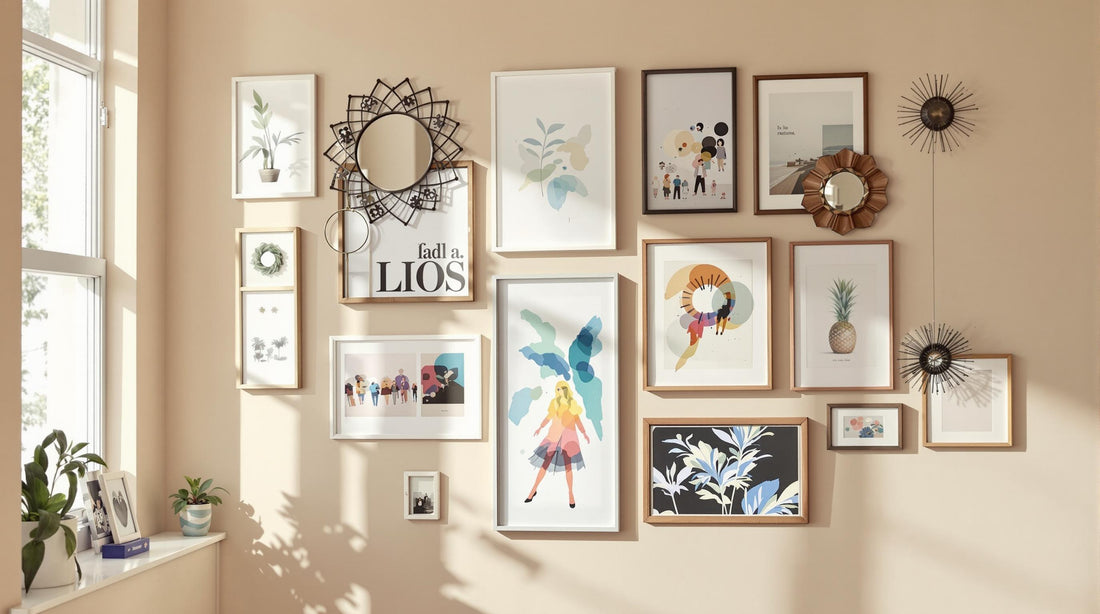Want to create a stunning gallery wall for your home? Here's how:
- Pick a Theme: Choose a style that complements your space, like bohemian, celestial, or nature-inspired.
- Select Art Prints: Use the 60-30-10 color rule and mix frame sizes (large, medium, small) for variety.
- Plan the Layout: Test arrangements with digital tools or paper templates. Keep artwork centered at 60 inches from the floor.
- Hang Frames: Use Command strips for lightweight frames or hardware for heavier ones. Start with a central piece and work outward.
- Add Final Touches: Balance frame sizes and colors, leave negative space, and include decorative elements like plants or mirrors.
Pro Tip: Consistent spacing (3-6 inches) and a mix of frame finishes (up to three) create a polished look. Ready to get started? Let’s dive into the details!
Step 1: Selecting a Theme and Art Prints
Picking a Theme
Choosing the right theme sets the tone for your gallery wall and ties it together with your home decor. Think about your personal style and the main elements in your space when deciding.
Some popular themes include:
- Bohemian: A mix of patterns, bold colors, and eclectic frames.
- Celestial: Stars, moons, and cosmic imagery.
- Nature-inspired: Botanicals, landscapes, and wildlife.
- Monochromatic: Shades within a single color palette.
Pick a theme that enhances your space and resonates with your personality.
Choosing Art Prints
Follow the 60-30-10 rule for color balance: 60% of your prints should feature a dominant color, 30% a complementary shade, and 10% an accent color. This creates a balanced yet engaging look.
Frames play a big role in the overall aesthetic. Mix materials like wood and metal, or pair ornate frames with simple ones for a striking contrast. Match frame tones to your room's vibe - wood adds warmth, while black or metallic finishes bring a sleek, modern feel [4].
Art Print Sources
Look for high-quality prints that align with your theme. Prioritize durable materials and vibrant resolution from trusted sellers.
To add depth and movement to your gallery wall, mix up the sizes:
- Large prints: A1/A2 sizes.
- Medium prints: A3 size.
- Small prints: A4 size.
This variety not only keeps things visually interesting but also helps guide the eye naturally across the wall.
Once you’ve nailed down your theme and selected your prints, it’s time to arrange them in a layout that works for your space.
How to Create the Ultimate Gallery Wall
Step 2: Planning the Layout
Careful planning is key to creating a gallery wall that looks cohesive and avoids mistakes.
Using Digital Tools
For a professional approach, Adobe Illustrator is a great option for designing scaled layouts:
- Scale your wall to match its actual dimensions.
- Use rectangles to represent each frame, adjusting them until you find the best arrangement.
If Adobe Illustrator feels too complex, there are online gallery wall planners that make it easier to test different configurations.
Testing Layouts with Templates
Sometimes, physical templates can reveal details that digital tools might miss. Use sturdy paper like kraft or parcel paper to cut out templates the size of your frames. Stick these to the wall with painter's tape to get a sense of the spacing, proportions, and overall look.
"Arrange pictures on the floor first and snap a photo to plan before committing", says interior designer Sophie Robinson [5].
Keep spacing consistent between frames. Start with a central piece and build outward to achieve balance. Be mindful of practical elements like light switches, outlets, furniture placement, natural light, and how the wall will be viewed.
For the best results, align the center of your gallery wall at 60 inches from the floor - a comfortable eye level [4].
Once you're happy with the layout, you're ready to start hanging your gallery wall!
sbb-itb-78c8b21
Step 3: Hanging the Gallery Wall
Now that your layout is finalized and looks great, it’s time to put it up on the wall using accurate hanging techniques.
Measuring and Marking
Grab a laser level and measuring tape to transfer your layout onto the wall. Use light pencil marks to outline where each frame will go. Mark both the top and bottom edges of the frames to keep everything aligned. The laser level helps you create straight, even lines across the wall for a polished look.
Hanging Methods
If you’re looking for a renter-friendly option or working with lightweight frames, Command strips are a great choice - they’re easy to adjust and won’t damage your walls. For heavier frames or permanent setups, stick with traditional hanging hardware for extra security.
Start by hanging your central piece first. This will act as a guide for placing the rest of the frames. Work your way outward, double-checking the spacing and making sure everything stays level. If you’re using Command strips, make sure the wall is clean and dry before applying them to ensure they stick properly.
Once all the frames are up, you can shift your focus to any final touches that will make your gallery wall truly stand out.
Step 4: Finalizing the Design
Balancing Sizes and Colors
Once your frames are up, step back and take a look at the overall balance of your gallery wall. The goal is to create a visually pleasing arrangement. Start by focusing on your central piece and how the surrounding frames work with it. Larger statement pieces should be offset by smaller frames on the opposite sides to keep things balanced.
For colors, stick to a palette that ties the wall together. Limit your frame finishes to three options, like black, white, or wood, and choose ones that match the room's vibe. Interior designer Emily Henderson suggests this three-frame approach because it offers variety without looking chaotic [3]. Warm-toned rooms pair well with wooden frames for a cozy feel, while black or metallic frames work best in cooler-toned spaces [4].
Adding Decorative Items
With your art and layout in place, it’s time to bring in decorative touches that enhance your gallery wall’s style. These items can elevate the display and make it a true focal point in the room.
Consider adding:
- Plants: Small potted plants on floating shelves add a natural, textured element.
- Mirrors: Use mirrors of different sizes to reflect light and create depth.
- Dimensional objects: Items like small sculptures or textured pieces add interest.
CB2 advises leaving some negative space to avoid a cluttered look [1]. This ensures your gallery wall feels thoughtfully arranged rather than overwhelming.
Conclusion: Completing Your Gallery Wall
Once your gallery wall is up, take a moment to review and fine-tune the layout. This final step ensures your wall achieves the right balance and transforms into a striking centerpiece that reflects your story and style.
Plan First for a Seamless Process
Experts often suggest using tools like Adobe Illustrator to map out your design before you start hanging [2]. Laying out your vision digitally helps you avoid guesswork and ensures the final result matches your expectations.
Choosing Frames and Art with Intention
Keep the spacing between frames consistent - aim for 5-10cm - for a polished appearance [5]. Stick to no more than three frame finishes to maintain harmony while still allowing for some variety. The art itself is the star of your gallery wall, so pick prints that align with your theme and personal taste. Use a mix of sizes to create depth and keep your display visually engaging.
Perfecting the Look
Step back frequently to evaluate how the pieces work together. Larger frames or bold artwork can act as anchors, while smaller ones offer contrast and balance. Consistent spacing and a bit of negative space will keep the arrangement clean and visually appealing.
Your gallery wall is a personal statement. Feel free to experiment with layouts and make adjustments until everything feels just right. The result will be a vibrant display that adds character and charm to your space.
FAQs
Now that your gallery wall is up, here are answers to some common questions to help fine-tune your design or guide future projects.
How do I arrange a gallery wall with different frame sizes and styles?
Start with a large centerpiece to anchor the layout. Place the second-largest frame diagonally from it, then use smaller frames to fill the gaps. To keep things interesting, mix frame finishes, but limit matching finishes to two adjacent pieces for balance. Using layout planning tools (like the ones mentioned in Step 2) can make it easier to visualize before hanging anything on the wall.
What’s the ideal spacing between picture frames?
Aim for 3-6 inches of space between frames and along all sides for a balanced look. This approach works especially well with mixed frame sizes. Emily Henderson’s method of combining white, black, and wood frames is a great example of how spacing and varied finishes can create a cohesive design [3]. For consistent spacing, try cutting a piece of cardboard to your desired width and use it as a guide.
"The tone of your space or the space you are trying to create is an important to-do before you start looking at and buying frames." - JoLouDesign [4]

